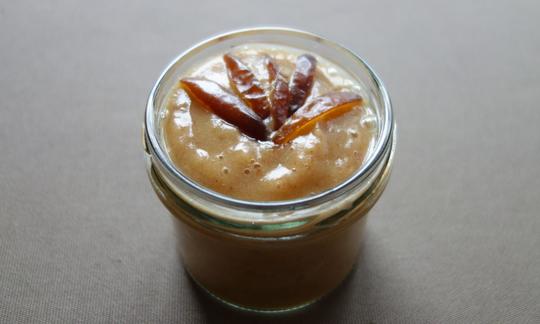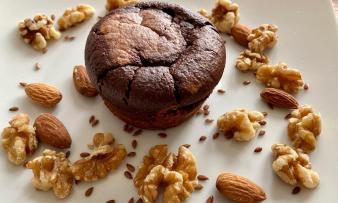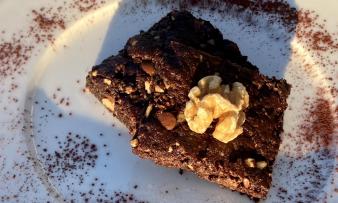Table of contents
Date syrup is a viscous sweetener consisting of pureed dates ( Phoenix dactylifera).
Use in the kitchen
Date syrup has been used in the Orient for centuries as a natural, viscous sweetener. Date syrup is suitable for sweetening and refining muesli, desserts, ice cream, sauces or smoothies. The sweet, slightly caramel-like date syrup can also be used to round off hearty vegetable dishes or rice dishes. It is very popular for baking, where date syrup is used instead of sugar. If you want to replace sugar with date syrup, you can use a ratio of 1:1. The sweetness of date syrup is less than that of granulated sugar, so you need a larger amount of date syrup for the same intensity. However, moderation is also advised here. Although it is called for as a syrup, it cannot be used as such. However, it is an excellent vegan alternative to honey and tastes good as a spread.
Homemade date syrup contains fewer calories and sugar than store-bought date syrup, agave syrup, maple syrup, rice syrup and coconut blossom syrup.
date
Making your own syrup is easy. The recipe by Dr. Michael Greger from "The How Not to Die Cookbook" only requires dates, water and lemon.
For this you will need mainly dried, pitted, unsweetened dates. The Medjool variety is ideal due to its unique fruity taste, size and soft consistency. However, you can use the cheaper Deglet Nour dates if you want to use the date syrup primarily as a sweetener for desserts and pastries. The recipe uses water and a whole lemon (without peel). Alternatively, you can use freshly squeezed orange juice as the liquid. Soak the dates in boiling water for an hour. Then puree the whole thing with a high-performance blender until there are no more pieces. For the recipe as a raw food, simply use lukewarm water (< 40 °C) and cover the bowl with a lid to soak.
Vegan recipe for millet porridge with date syrup
Ingredients (for 4 people): 200 g millet, 150 ml drinking water, 300 ml oat drink (alternatively rice drink, almond drink), 1-2 tsp date syrup. Seasonal fruit as a topping.
Preparation: For the porridge, bring 150 ml of water and oat drink to the boil. Add the millet and stir. Then simmer everything over a low heat for about 15 minutes, stirring frequently so that it doesn't burn. If the millet porridge is too dry, add a little more water. Finally, mix 1-2 teaspoons of date syrup into the porridge. Pour the finished porridge into a bowl and garnish with fresh fruit.
Vegan recipes with date syrup can be found under the note: " Recipes that have the most of this ingredient ".
| Not only vegans or vegetarians should read this: Vegans often eat unhealthily. Avoidable nutritional mistakes. |
Purchasing - Storage
Major retailers such as Coop, Migros, Rewe and Edeka sell date syrup, sometimes in organic quality. Denner, Volg, Spar, Aldi, Lidl, Hofer and Billa rarely stock date syrup. You can also buy date syrup in online shops, health food stores and organic supermarkets such as Denn's Biomarkt and Alnatura. You can find it in the range all year round. When buying date syrup, make sure it is made naturally. Artificially produced date syrup only contains various types of sugar and flavors, but no ingredients typical of dates that are responsible for the health effects.
The availability of date syrup varies depending on the size of the store, catchment area, etc. If you are interested, click on our recorded food prices for the DA-CH countries (above under the ingredient image). There you will find current prices from various supermarkets and their price development.
Storage tips
The shelf life of date syrup depends on how it is prepared. The cooked version lasts for about 2-3 weeks in the fridge. It is best to fill the date syrup into a jar from which you can easily remove the syrup with a spoon. We advise against filling it into bottles as the consistency of the date syrup is very thick. The best way to store the raw version is to put it in the fridge and make sure it is used up quickly.
Ingredients - Nutritional values - Calories
Date syrup according to the recipe by Dr. Michael Greger from "The How Not to Die Cookbook" contains only 94 kcal per 100 g of date syrup. It also contains some fiber (2.5 g/100g) and is almost fat-free (0.09 g/100g). Date syrup has a high sugar content of 22 g/100g, as dates naturally contain a lot of sugar. The carbohydrate content is 26 g/100 g plus a low protein content of 0.73 g/100 g. 1 Date syrup contains copper, potassium and, thanks to the lemon, vitamin C (ascorbic acid). 1
These ingredients are based on the conversion according to the nutritional values of the individual ingredients. Store-bought date syrup deviates greatly from this nutritional profile. The energy content is much higher at 310 kcal. With 71 g of sugar per 100 g of syrup, the sugar content is also quite a bit higher and so is the carbohydrate content (74.2 g/100g). The fiber content (2.7 g/100g) and fat content (0.2 g/100g) are similar. It contains a little more protein (1.5 g/100 g). 9
The complete ingredients of date syrup, the coverage of the daily requirement and comparison values with other ingredients can be found in our nutrient tables below the ingredient image.
Health effects
Is date syrup healthy? Date syrup is rich in polyphenols, tannins, flavonoids (such as flavanols, flavonols, etc.), which are known to be powerful antioxidants. Antioxidants reduce the risk of chronic diseases (e.g. cardiovascular disease, cancer and diabetes) and promote general health and well-being. 10 Numerous phenolic compounds such as polyphenols and flavonoids also have antibacterial effects due to their oxidizing potential, which is why it acts like a natural "antibiotic". Studies have shown that the extracted polyphenols can inhibit the growth of bacteria. This is why date syrup is said to have an antibacterial effect. 5 Date syrup is traditionally used for wound healing 5, as well as for colds, sore throats and coughs. 6 Date syrup is therefore a great vegan alternative to honey, which is also antibacterial. A great combination is date syrup in ribwort plantain tea, which is known for its expectorant effect on coughs.
Several studies show that eating dates in the last weeks of pregnancy and during labor can shorten labor, promote dilation of the cervix, and reduce the likelihood of needing labor induction drugs. 13,14 This is attributed to the fact that dates are excellent sources of energy, with high glucose content. The tannins contained in dates also promote the contraction of the smooth muscles of the cervix. 13 These effects were also evident when consuming date syrup. 15 However, further studies are needed to understand the positive effect of dates on the birth process in more detail.
Dangers - Intolerances - Side effects
Is date syrup unhealthy? Store-bought date syrup is partly artificially produced and therefore has no antibacterial effect. It only contains various types of sugar and flavors, but no polyphenols typical of dates. Since the energy and sugar content is much higher than in homemade date syrup, it is worth making your own ( recipe here).
Allergies to dates are rare, but have been proven. 7 The fructose content is quite high, which is why people with a sensitivity to fructose should avoid date syrup. 8
Ecological footprint - animal welfare
The ecological CO2 footprint of date syrup depends on the country of origin of the dates, the corresponding transport and the processing method. To produce date syrup, fresh dates are used and boiled in water for a long time; after filtering, the liquid date syrup remains. 16 This can usually be bought in plastic packaging or jars, which in turn have an impact on the ecological CO2 footprint. The production and melting of glass, for example, requires a lot of energy and produces correspondingly high CO2 emissions. The weight during transport also has a negative effect. 17 Plastic packaging is lighter and allows the syrup to be taken out in portions, which can prevent it from spoiling quickly. But emissions are also generated during plastic production and if disposed of improperly, plastic often ends up in the environment, where it decomposes very slowly, which in turn leads to other ecological problems. To save some of the packaging, you can also make your own date syrup from dried dates.
The main sources of emissions from date cultivation are pesticides, nitrogen fertilizers and motor fuel.18 However , date palms are particularly efficient at storing carbon, which in turn reduces their ecological footprint. A major problem with date cultivation, however, lies in the way it is cultivated - date palms often grow in monocultures, where they are susceptible to diseases and pests, and synthetic pesticides and herbicides are used to prevent these. 19 A study recorded measurements of pesticide residues and heavy metal contamination in dates from Iran and found values that were far above the levels considered safe. 20 Ideally, when buying dates and date syrup, you should buy organically grown goods.
The amount of water required to produce 1 kg of dates is 2277 litres. 22 Since the main growing countries tend to be areas with little rainfall, this amount is considerable and some people resort to artificial irrigation, which in turn could be important drinking water. The amount of water required to produce date syrup is most likely increased due to the additional production steps.
Worldwide occurrence - cultivation
The date is one of the oldest known fruit crops. It has been cultivated in North Africa and the Middle East for at least 5000 years. Due to the long history of date cultivation and the wide distribution and exchange of date varieties, the exact origin (gene center) of the date is unknown, but it most likely originates from ancient Mesopotamia (Iraq, Syria) or the West Indies. 4
In international trade, no distinction is made between the individual date varieties. According to FAOSTAT, around 9.66 million tons of dates were grown worldwide in 2021. The main growing areas were Egypt (1.75 million tons), Saudi Arabia (1.57 million tons) and Iran (1.30 million tons). 2
For more information on growing and harvesting dates, see the ingredient Deglet Nour dates.
Industrial production
Date syrup is often made from medium and low quality dates. First, the dates are sorted and bad fruit is removed. Then they are mixed with water and the date-water mixture is heated (60 °C). The mass is pressed and the date juice is filtered. This is heated again so that the excess water can evaporate and a thick date syrup is created. In some cases, another filtering takes place. Finally, the date syrup is bottled or packaged. 12
Date syrup is sold as a finished product or used to make ice cream, drinks, baked goods or jam. It is sometimes used as a natural food coloring or flavoring. 11
Further information
The date palm ( Phoenix dactylifera) is a plant species of the date palm genus ( Phoenix) in the palm family (Arecaceae). Dates can be divided into three main groups: soft dates (including Medjool), semi-dry dates and dry dates. Most dates sold worldwide are of the semi-dry variety. The exact number of date varieties is unknown (probably around 400). There are over 100 varieties of Arabian dates alone. 7 well-known varieties are: Medjool, Deglet Nour, Khidri dates, Ajwa, Yahidi, Hallawi and Mazafati dates.
Dates are known as the "bread of the desert" because they are an important foodstuff in the growing areas. That is why a large proportion remains in the producing countries. In addition to the fruit, date palms also produce date oil, date liquor and date vinegar.
Alternative names
In English it is called date syrup. The name silan comes from the Hebrew and is used for thick date syrup.
Bibliography - 18 Sources (Link to the evidence)
| 1. | USDA United States Department of Agriculture. |
| 2. | FAOSTAT Food and Agriculture Organization of the United Nations. Dates (2021). |
| 4. | Chao CT, Krueger RR. The Date Palm (Phoenix dactylifera L.) Overview of Biology, Uses, and Cultivation. HortScience horts. 2007;42(5): 1077-1082. |
| 5. | Taleb H, Maddocks SE, Morris RK, Kanekanian AD. The Antibacterial Activity of Date Syrup Polyphenols against S. aureus and E. coli. Front Microbiol. 2016 Feb 26;7: 198. |
| 6. | El Hadrami A, Al-Khayri J. Socioeconomic and traditional importance of date palm. Emir J Food Agric. 2012;24(5): 371-385. |
| 7. | Kwaasi AA, Harfi HA, Parhar RS, Collison KS, Al-Sedairy ST, Al-Mohanna FA. Cultivar-specific IgE-epitopes in date (Phoenix dactylifera L.) fruit allergy. Correlation of skin test reactivity and ige-binding properties in selecting date cultivars for allergen standardization. Int Arch Allergy Immunol. 2000 Oct;123(2): 137-44. |
| 8. | Vayalil PK. Date fruits (Phoenix dactylifera Linn): an emerging medicinal food. Crit Rev Food Sci Nutr. 2012;52(3): 249-71. |
| 9. | ÖNWT Die Österreichische Nährwerttabelle. Dattelsirup. |
| 10. | Taleb H, Maddocks SE, Morris RK, Kanekanian AD. Chemical characterisation and the anti-inflammatory, anti-angiogenic and antibacterial properties of date fruit (Phoenix dactylifera L.). J Ethnopharmacol. 2016 Dec 24;194: 457-468. |
| 11. | Najjar Z, Stathopoulos C, Chockchaisawasdee S. Utilization of Date By-Products in the Food Industry. Emirates Journal of Food and Agriculture 2020 Nov;32(11): 808-815. |
| 12. | Farahnaky A, Mardani M, Mesbahi G., Majzoobi M. Some physicochemical properties of date syrup, concentrate, and liquid sugar in comparison with sucrose solutions. Journal of Agricultural Science and Technology. 2016 Jan;18(3): 657-668. |
| 13. | Kordi M, Meybodi FA, Tara F, Fakari FR, Nemati M, Shakeri M. Effect of Dates in Late Pregnancy on the Duration of Labor in Nulliparous Women. Iran J Nurs Midwifery Res. 2017 Sep-Oct;22(5): 383-387. |
| 14. | Bagherzadeh Karimi A, Elmi A, Mirghafourvand M, Baghervand Navid R. Effects of date fruit (Phoenix dactylifera L.) on labor and delivery outcomes: a systematic review and meta-analysis. BMC Pregnancy Childbirth. 2020 Apr 14;20(1): 210. |
| 15. | Sohrabi H, Shamsalizadeh N, Moradpoor F, Shahoei R. Comparison of the effects of Date Syrup with Saffron-Honey Syrup on the Progress of Labor in Nulliparous Women: A Single Blind Randomized Clinical Trial. Iran J Nurs Midwifery Res. 2022 Aug 9;27(4): 301-307. |
| 16. | Neumann S. Datteln - ein gesunder Snack mit mieser Ökobilanz. Aufgerufen am 11.07.2023 auf: https://utopia.de/ratgeber/datteln-kaufen-naehrwerte-anbau/ |
| 17. | Ghenai C. Life Cycle Assessment of Packaging Materials for Milk and Dairy products. Int. J. of Thermal & Environmental Engineering Volume 4.2012; 117-128 |
| 19. | Meresereau T. The Environmental Impact of Dates: From Farm to Table. Aufgerufen am 07.07.2023 auf: https://impactful.ninja/the-environmental-impact-of-dates/ |
| 20. | Jafarian AP, Niazmand R, Razavizadeh BM, et al. Monitoring of pesticide and some metal residues in Mazafati date fruit cultivar and risk assessment to the health. Journal of Food Composition and Analysis. 2023. |











Comments